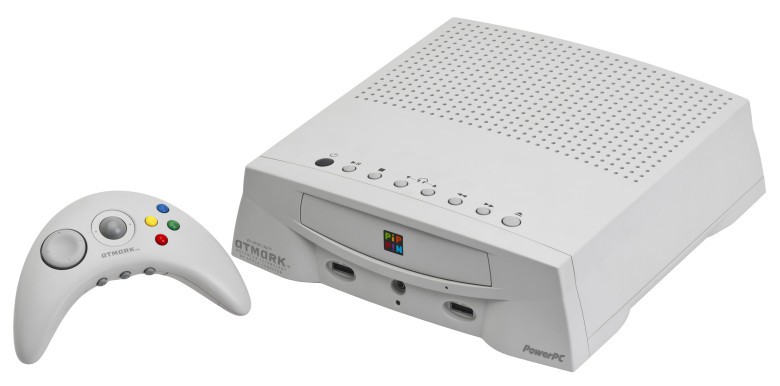One of the most eagerly-anticipated features of the new Apple TV, set to be unveiled today, is that it will be geared toward the gamer market — maybe even taking on console powerhouses like the Xbox One and PlayStation 4.
Although Apple dominates mobile gaming thanks to the iPhone and iPad, this will be the company’s first stab at making a device where games are one of the primary features. Right?
Wrong! Back in 1995, Apple launched its own-brand games console, the Pippin. Despite some good ideas, it sank like a rock.
Here’s what Apple learned from that sales disaster, and why it won’t make the same mistake twice.
There was a lot to like about the Pippin. Designed by Apple, but built and marketed by toy-maker Bandai (Apple received tiny royalties of $10 to $20 per machine and $1 per game disk), the device was viewed inside Apple as a potential saviour for the company in its hour of need.
It wasn’t.
With that said, though, watch the below video and tell me that you’re not amazed by how similar (in overall vision, not specific tech) the Pippin was to what Apple is set to announce in a few short hours:
So what went wrong, and how is Apple avoiding similar errors here in 2015? Let’s count the ways.
Price Point
Apple devices are still pricey, but not what they were in the late 1980s/early 1990s, when the SE/30 Mac cost a whopping $4,369. The Pippin sold (or, rather, didn’t sell) for $599. That was much higher than the $299 PlayStation and the N64’s $250 price point.
If you can buy two far more popular rivals for the price of your debut into an already crowded market, you’re doing something very wrong!
We don’t yet know the pricing involved with today’s Apple TV, but it is likely to be far more competitive. Price tags are reported to start at $149, while monthly subscription costs will be in line with set-top box rivals. An Xbox One and PlayStation 4, by comparison, costs $400.
Game Selection
I’ll give the Pippin this: at a time when storage was at a premium, its entire library of titles could fit into an impressively small amount of space. Like, a shoebox.
When you’re already more expensive than more popular consoles, it’s a good idea to have more than 22 titles available. Particularly if one of them is “Web Browser.” I am intrigued by the Beats deal-predicting Dr. Dre general knowledge game, however. Wait, that’s not what Compton’s Interactive Encyclopedia was? Damn.
All joking aside, there were a few good titles on Pippin — just not nearly enough. In an age in which the App Store is crowded by developers, expect today’s Apple TV refresh to have the opposite problem.
Lack of Trust
Apple had some pretty hardcore fans in the 1990s, but even they couldn’t blamed for steering clear of a new device taking Apple into uncharted waters. The Apple Pippin made plenty of promises for the future, but 90s Apple did that a lot… only to cancel support for your latest purchase as soon as you were clear of the store.
The Pippin lasted around two years — although it was pulled from the majority of retailers long, long before then.
Poor Product Definition
I’ve interviewed plenty of Apple engineers from the 1990s who joke about working on products which were meant as a “dessert topping as well as a floor wax” — meaning that they were supposed to do everything, but ended up doing nothing well.
The Pippin was kind of a games console, but not really because it barely had any games. It was kind of an Internet browser, but not really because (then) current TVs weren’t good enough for Internet browsing, Apple opted for a 14.4-kbps modem which took forever to load pages, and barely anyone was using the Internet in 1995.
So what was the Pippin? No-one really knew, which is probably why only 42,000 models out of the 100,000 ever built got sold.

Even with these failures, though, I’ll be honest: I’ve got a massive soft spot for 1990s Apple tech. Part of it is nostalgia, but the other part is that Apple often had some ahead-of-its-time ideas, which just never quite clicked.
The Apple Newton, for example, is no longer considered a bomb, so much as it is the predecessor to the iPad and one of the most influential devices of the 1990s.
The Apple QuickTake 100 camera probably sold 10 copies total (9 of them to Apple engineers) back in the day, but paved the way for a time when our iPhones overtook our SLRs as our most-used cameras.
The original Apple TV was a weird hybrid of a Performa 520 Mac and a 14-inch Sony Trinitron CRT television. It lasted four months because no-one understood the concept, but it doesn’t seem too weird in an age of streaming content and tech companies becoming production studios.
Even the zany Planet Hollywood-style Apple Café (complete with FaceTime-esque video chat and iPads built into the tables) seems like it has shades of today’s Apple Stores: an Apple-branded place cool enough that you’d actually want to hang out there.
The Pippin wasn’t a bad idea. To mangle a Steve Jobs-ism, it’s just that Apple was holding it wrong in 1995.
This time I have every faith they’ll get it right.


